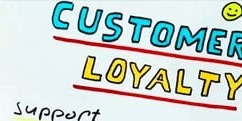How to Create a Customer Loyalty Program that Works
September 05, 2018 (0 comments)

Loyalty programs provide one of the best ways to turn regular customers into loyal fans. Rewards offer incentives for customers to increase their order value and to shop more often. Many brands offer loyalty programs but not all of them are successful. Just simply having a loyalty program won’t encourage customers to take action. They have to be cleverly created to offer rewards that are attractive to customers, easy to understand and easy to redeem. Here, I’ll provide you a step by step guide to start your first loyalty program. Let’s dive in!
Analyze Customer Data
The first step towards creating a program that works is learning customer behavior. Analyze your customer order history and shopping pattern. How often does your average customer come back to your store? What is their average order value?
These answers will help you define your reward tiers. For instance, if you find out that your average customer order value is $200, you can set up rewards for every $200 spent. However, if your store just has a $30 average order value, setting the first reward for $200 may seem too unattainable. You want to choose tiers that are slightly higher than your average order value, but that don’t feel out of reach.
Also, find out what are your best sellers and the products that need more attention. In that way, you’ll be able to direct your efforts towards promoting the products that need it the most. Maybe you can provide double points for purchasing specific products. By the end of this analysis, you should have a better idea of the different reward tiers you’ll be able to offer.
Define Different Tier Levels and Rewards
Setting up different reward tiers will enable you to classify customers according to spend and better tailor your rewards towards them. It also provides customers a competitive feeling similar to the one experienced in games, where they can go up levels to win bigger prizes. This can be appealing to many customer personas. See how Saks Fifth Avenue offers their reward system in different tier levels:


You can see how higher spend is tied together with higher member levels and bigger rewards. These perks are offered when customers get one of their credit cards, but you can apply the same idea without it. These monetary tier levels would also make sense for fine jewelry stores that usually have a high average order value.
Notice how their points were not associated with discounts, but with special perks. This strategy may be more effective targeting luxury buyers that can be more attracted to the VIP experience rather than the discount. Alternatively, you can provide both perks and discounts. See how Ulta offers both below:

Everyday free shipping with a smaller than usual shipping limit can be very attractive. Find some basic ideas to get started below:
Basic tier levels:
Reward ideas:
- Early access to special sales events like Black Friday and Cyber Monday
- Free shipping for a smaller order minimum than the one displayed on the site
- Discounts based on tier levels. For example, $10 off for silver, $20 for gold and $50 for platinum members.
Consider Other Reasons to Reward Customers
Purchases are not the only reason to reward customers. Referrals should also be rewarded in the same fashion. They can actually be more powerful than just purchases because they help spread the word about your business and attract new customers who may not have known about your store otherwise. Also, a recommendation from a friend or family member is more powerful than simple advertising, so that gives referrals even more weight.
The best kind of referral rewards are the ones that benefit the person sharing and the person receiving the offer (two-way referral). They can help you increase conversions because the people in your program get more motivated to share something that can also benefit them.
Choosing a Rewards Platform and Setting up the Page
Now that you have a better idea of what you’ll offer and how the system will work, it’s time to choose a rewards platform that will allow you to put this plan into action. There are plugins like this one built by Smile.io that can help you do pretty much everything we’ve stated above. If you have WooCommerce, try Beans Rewards and Loyalty. It’s highly rated online.
Once you’ve picked the right rewards platform for your business, take all your program instructions and features and enter them on a page where your customers can easily learn about the program. You’ll also need to set up emails to promote the program.
Every new customer should receive an email explaining the program. Customers can be automatically in as a low tier member so there would be minimal effort on their part to take the next step. You’ll need more emails after that initial one to keep customers engaged. See how Ulta lets customers know they have moved to the next tier below:

These are just some of the emails you should be prepared to send:
- Intro email
- Points earned email
- “You’ve moved to the next tier” email
These emails will help you increase awareness and excitement about your loyalty program. They are also easy to forward to someone else to help spread the word.
 Loyalty programs provide one of the best ways to turn regular customers into loyal fans. Rewards offer incentives for customers to increase their order value and to shop more often. Many brands offer loyalty programs but not all of them are successful. Just simply having a loyalty program won’t encourage customers to take action. They have to be cleverly created to offer rewards that are attractive to customers, easy to understand and easy to redeem. Here, I’ll provide you a step by step guide to start your first loyalty program. Let’s dive in!
Loyalty programs provide one of the best ways to turn regular customers into loyal fans. Rewards offer incentives for customers to increase their order value and to shop more often. Many brands offer loyalty programs but not all of them are successful. Just simply having a loyalty program won’t encourage customers to take action. They have to be cleverly created to offer rewards that are attractive to customers, easy to understand and easy to redeem. Here, I’ll provide you a step by step guide to start your first loyalty program. Let’s dive in!

 You can see how higher spend is tied together with higher member levels and bigger rewards. These perks are offered when customers get one of their credit cards, but you can apply the same idea without it. These monetary tier levels would also make sense for fine jewelry stores that usually have a high average order value.
Notice how their points were not associated with discounts, but with special perks. This strategy may be more effective targeting luxury buyers that can be more attracted to the VIP experience rather than the discount. Alternatively, you can provide both perks and discounts. See how Ulta offers both below:
You can see how higher spend is tied together with higher member levels and bigger rewards. These perks are offered when customers get one of their credit cards, but you can apply the same idea without it. These monetary tier levels would also make sense for fine jewelry stores that usually have a high average order value.
Notice how their points were not associated with discounts, but with special perks. This strategy may be more effective targeting luxury buyers that can be more attracted to the VIP experience rather than the discount. Alternatively, you can provide both perks and discounts. See how Ulta offers both below:
 Everyday free shipping with a smaller than usual shipping limit can be very attractive. Find some basic ideas to get started below:
Basic tier levels:
Everyday free shipping with a smaller than usual shipping limit can be very attractive. Find some basic ideas to get started below:
Basic tier levels:
 These are just some of the emails you should be prepared to send:
These are just some of the emails you should be prepared to send:


